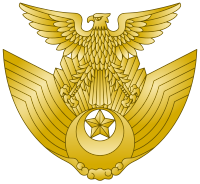
Back قوة الدفاع الذاتي الجوية اليابانية Arabic Zračne odbrambeno-oružane snage Japana BS Força Aèria d'Autodefensa del Japó Catalan Japonské vzdušné síly sebeobrany Czech Luftselbstverteidigungsstreitkräfte German Fuerza Aérea de Autodefensa de Japón Spanish نیروی هوایی دفاعازخود ژاپن Persian Force aérienne d'autodéfense japonaise French כוח ההגנה העצמית האווירי של יפן HE Japán Légi Véderő Hungarian
| Japan Air Self-Defense Force | |
|---|---|
| |
 Emblem of the Air Self-Defense Force | |
| Founded | 1 July 1954[1] |
| Country | |
| Type | Air force Space force |
| Role | |
| Size |
|
| Part of | Japan Self-Defense Forces |
| Headquarters | Ichigaya, Shinjuku, Tokyo |
| Motto(s) | "Key to Defense, Ready Anytime!" |
| Website | www |
| Commanders | |
| Commander-in-Chief | Prime Minister Shigeru Ishiba |
| Minister of Defense | Gen Nakatani |
| Chief of Staff, Joint Staff | General Yoshihide Yoshida |
| Chief of Staff, Air Self-Defense Force | General Hiroaki Uchikura |
| Insignia | |
| Roundel |   |
| Flag |  |
| Aircraft flown | |
| Electronic warfare | E-767, EC-1, E-2C/D, YS-11EA/EB |
| Fighter | F-15J/DJ, F-2A/B, F-35A/B |
| Helicopter | UH-60J, CH-47J (LR) |
| Trainer | T-3, T-7, T-400, T-4 |
| Transport | C-1, C-2, C-130H, Hawker 800, Gulfstream IV, Boeing 777 |
| Tanker | KC-767, KC-130 |
The Japan Air Self-Defense Force (Japanese: 航空自衛隊, Hepburn: Kōkū Jieitai), JASDF (空自, Kūji), also referred to as the Japanese Air Force,[2] is the air and space branch of the Japan Self-Defense Forces, responsible for the defense of Japanese airspace, other air and space operations, cyberwarfare and electronic warfare.[3] The JASDF carries out combat air patrols around Japan, while also maintaining a network of ground and air early-warning radar systems. The branch also has an aerobatic team known as Blue Impulse and has provided air transport in UN peacekeeping missions.
The JASDF had an estimated 49,913 personnel as of 2018, and as of 2023 operates about 712 aircraft, approximately 321 of them being fighter aircraft.[4]
The service will be renamed in 2027 to the Japan Air and Space Self-Defense Force (航空宇宙自衛隊, Kōkū Uchū Jieitai), in recognition of the increasing importance of the space domain.[5]
- ^ a b "What is JASDF?|ORGANIZATION | [JASDF] Japan Air Self-Defense Force". www.mod.go.jp. Retrieved 20 December 2021.
- ^ Gao, Charlie (19 February 2018). "Japan's Air Force: The Best in Asia?". Archived from the original on 30 May 2018. Retrieved 29 May 2018.
- ^ "Mission". JASDF. Retrieved 15 November 2021.
- ^ Hoyle, Craig, ed. (2023). "World Air Forces 2024". Flight Global. Archived from the original on 5 January 2024. Retrieved 1 December 2023.
- ^ Robson, Seth; Kusumoto, Hana (11 October 2023). "Japan is renaming its air force as threats from above become more 'complex'". Stars and Stripes. Retrieved 12 October 2023.